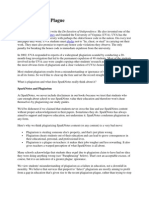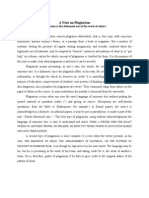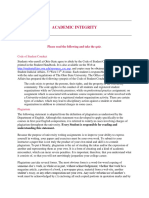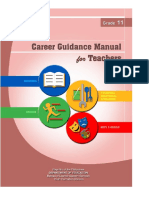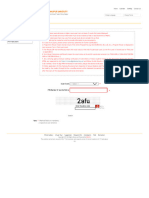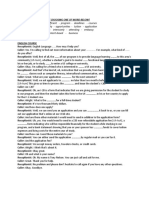Pshs Rule On Plagiarism
Pshs Rule On Plagiarism
Uploaded by
Jon ToresCopyright:
Available Formats
Pshs Rule On Plagiarism
Pshs Rule On Plagiarism
Uploaded by
Jon ToresOriginal Title
Copyright
Available Formats
Share this document
Did you find this document useful?
Is this content inappropriate?
Copyright:
Available Formats
Pshs Rule On Plagiarism
Pshs Rule On Plagiarism
Uploaded by
Jon ToresCopyright:
Available Formats
From the history of the word itself, “plagiarism” came from the Latin word plagiarus, which means
“kidnapper” (Merriam-Webster Dictionary, n.d.). Connecting its history to its modern use, plagiarism is a
form of theft of someone else’s concept or idea. It encourages intellectual dishonesty and destroys the
academic integrity not only of the scholar but also of the institution to which he or she is a part.
Imagine having a remarkable idea — be it an artistic output, an insightful essay, or simply an interesting
thought — only for other people to steal it and claim the idea as their own. As the creator of the content,
how would you feel about it? Not only is the source or the owner of the idea deprived of the rightful credit
or recognition, the one who committed plagiarism also performs academic misconduct and disrespects the
discipline involved in scholarship.
PSHS RULE ON PLAGIARISM
According to the PSHS System Student Code of Conduct (n.d.), plagiarism, which falls under academic
dishonesty, is a ground for disciplinary action. Any PSHS student who is proven to have plagiarized may
face sanctions depending on the gravity of the offense. It can range from getting a reprimand from the
teacher, a zero mark for the plagiarized output, a meeting with the disciplinary officer, and even a
suspension if committed more than once.
COMMON FORMS OF PLAGIARISM
There are many forms of plagiarism, some of which may have been committed by students willingly or
unintentionally. Be wary of the following acts that may be considered plagiarism:
If you can notice, the different forms of plagiarism often fall short on two components: (1) the genuine
intention of the student to give proper acknowledgment of the existing source or different author of the
idea and (2) the adherence to the correct way of citing or acknowledging sources. You will learn more
about the second point in another module. The important thing to remember is to be honest with the work
you are presenting. If the idea is not yours, remember to indicate your source.
To assess whether an act can be considered an academic dishonesty or not, try asking these questions:
1. Is there a clear intention in our work to acknowledge the source or the author of the material we
borrowed idea/s from?
2. Is the acknowledgment done correctly and properly?
If you answered YES to both of these questions, then the act is likely honest and is done with the
sincerest intention of giving credit to the rightful owner of the idea.
You might also like
- Code of Conduct Reflection: Morgan Rogge Grand Canyon University UNV-103, University Success September 20, 2020Document3 pagesCode of Conduct Reflection: Morgan Rogge Grand Canyon University UNV-103, University Success September 20, 2020Morgan RogNo ratings yet
- Political Cartoons Lesson PlanDocument3 pagesPolitical Cartoons Lesson Planapi-256444300No ratings yet
- Plagiarism - Tanaka PolicyDocument1 pagePlagiarism - Tanaka PolicyLeonardo CanoNo ratings yet
- What Is PlagiarismDocument3 pagesWhat Is Plagiarismhi2joeyNo ratings yet
- Plagiarism - Types, Reasons, and ConsequencesDocument2 pagesPlagiarism - Types, Reasons, and ConsequencesImen AggouneNo ratings yet
- FA#5 Case StudyDocument3 pagesFA#5 Case StudyGail PerezNo ratings yet
- Plagiarism Is A Serious Academic OffenceDocument4 pagesPlagiarism Is A Serious Academic OffenceMachel GiftNo ratings yet
- Scholarly Writing CADocument4 pagesScholarly Writing CAMilan BiswasNo ratings yet
- The Wrongs of PlagiarismDocument11 pagesThe Wrongs of PlagiarismkillerqueenリンNo ratings yet
- The Plagiarism Plague: Macaroni Machines PledgeDocument4 pagesThe Plagiarism Plague: Macaroni Machines PledgeBayu Al-GhazaliNo ratings yet
- Criminals in Uniform Walking Intellectual ThievesDocument6 pagesCriminals in Uniform Walking Intellectual ThievesJoselito DenostaNo ratings yet
- Plagiarism Definition: Has Plagiarism Been Getting Worse in Recent Years?Document4 pagesPlagiarism Definition: Has Plagiarism Been Getting Worse in Recent Years?Sbl IrvNo ratings yet
- Plagiarism: in Fact, Academic Standards of Intellectual HonestyDocument2 pagesPlagiarism: in Fact, Academic Standards of Intellectual HonestyAbhilasha SinghNo ratings yet
- Chapter 2. PlagiarismDocument4 pagesChapter 2. PlagiarismPea Del Monte AñanaNo ratings yet
- Academic PlagiarismDocument5 pagesAcademic PlagiarismAstrini Wulandari DewanthiNo ratings yet
- RM ProjectDocument16 pagesRM Projectvaishnavi26gupta06No ratings yet
- Plagiarism PDFDocument6 pagesPlagiarism PDFحسنين غانم خضيرNo ratings yet
- Written Work MalalaDocument6 pagesWritten Work MalalaTrixie bhea PimentelNo ratings yet
- Ontology of PlagiarismDocument3 pagesOntology of PlagiarismAnaIordNo ratings yet
- Plagiarism, Citation of SourcesDocument19 pagesPlagiarism, Citation of Sourcesmonsignorzhaiky23No ratings yet
- Ethical Issues in Research WritingDocument4 pagesEthical Issues in Research WritingEditor IJTSRDNo ratings yet
- Research Ethics Assignment MamtaDocument4 pagesResearch Ethics Assignment MamtaMamta LuthraNo ratings yet
- A Note On PlagiarismDocument2 pagesA Note On Plagiarismzaruba78No ratings yet
- Backup of Importanace of Referencing and The Dangers of PlagiarismDocument2 pagesBackup of Importanace of Referencing and The Dangers of PlagiarismboipelomnNo ratings yet
- Back To School TipsDocument16 pagesBack To School TipsRejoice MpofuNo ratings yet
- Plagiarism and Vail: Universitas Sarjana Wiyata Taman Siswa 2013 / 2014Document16 pagesPlagiarism and Vail: Universitas Sarjana Wiyata Taman Siswa 2013 / 2014Bambang HuseinNo ratings yet
- How To Write Research Papers Without Being Called PlagiaristDocument29 pagesHow To Write Research Papers Without Being Called PlagiaristAyman HussienNo ratings yet
- Plagiarism in Legal ResearchDocument6 pagesPlagiarism in Legal Researchmuwonge ukashaNo ratings yet
- ALS Policies and Procedures On Academic Integrity and Plagiarism 11-23-18 PDFDocument7 pagesALS Policies and Procedures On Academic Integrity and Plagiarism 11-23-18 PDFArtisticLawyerNo ratings yet
- Plagiarism Detection Services Puropose and BenefitsDocument5 pagesPlagiarism Detection Services Puropose and BenefitsSamuel HagardtNo ratings yet
- Inquiry 2 Doc 3Document3 pagesInquiry 2 Doc 3api-284101596No ratings yet
- PlagiarismDocument1 pagePlagiarismHanane SaadaNo ratings yet
- Understanding Plagiarism: Qaiser IqbalDocument32 pagesUnderstanding Plagiarism: Qaiser IqbalSabir HussainNo ratings yet
- tmp4D8 TMPDocument44 pagestmp4D8 TMPFrontiersNo ratings yet
- Plagiarism 2Document3 pagesPlagiarism 2Vaibhav KashyapNo ratings yet
- Francisco PlagiarismDocument1 pageFrancisco PlagiarismeightNo ratings yet
- Assignment 3:: Group MembersDocument9 pagesAssignment 3:: Group Membershamza asadNo ratings yet
- Assignment 3: Report: Plagiarism and Its Role in Academia: Group MembersDocument9 pagesAssignment 3: Report: Plagiarism and Its Role in Academia: Group Membershamza asadNo ratings yet
- Plagiarism Ver 080510Document26 pagesPlagiarism Ver 080510rafid.abbasNo ratings yet
- EBP - Lec 10 NRS PlagDocument37 pagesEBP - Lec 10 NRS PlagshakheelataleeqNo ratings yet
- Activity: An Analysis of Institutional Defi Nitions of Plagiarism. Find A Defi Nition of PlagiarismDocument3 pagesActivity: An Analysis of Institutional Defi Nitions of Plagiarism. Find A Defi Nition of PlagiarismFilip MihaelNo ratings yet
- Plagiarism (Purposive)Document26 pagesPlagiarism (Purposive)Hattie Rhonwen DeidreNo ratings yet
- Academic Integrity AssignmentDocument3 pagesAcademic Integrity Assignmentapi-352944345No ratings yet
- Tutorial Section 1 April 11 2022Document2 pagesTutorial Section 1 April 11 2022junainaibrahim02No ratings yet
- Why Should Plagiarism Be Avoided by Students ?Document5 pagesWhy Should Plagiarism Be Avoided by Students ?Avinaash VeeramahNo ratings yet
- Plagiarism PDFDocument28 pagesPlagiarism PDFRahmat MaulanaNo ratings yet
- 5 Academic Honesty PPT and WorkshopDocument30 pages5 Academic Honesty PPT and WorkshopethanqianNo ratings yet
- Ethics PlagiarismDocument24 pagesEthics PlagiarismHanane SaadaNo ratings yet
- Academic Honesty, Academic Dishonesty, and Plagiarism: What Liberty University Says About ItDocument23 pagesAcademic Honesty, Academic Dishonesty, and Plagiarism: What Liberty University Says About ItKaitlyn Reese100% (1)
- What Is Plagiarism in ResearchDocument5 pagesWhat Is Plagiarism in Researchprakash.omprakash.om1No ratings yet
- Academic Integrity ReadingDocument3 pagesAcademic Integrity ReadingNatalie KittleNo ratings yet
- Plagiarism Exercise 3 PDFDocument5 pagesPlagiarism Exercise 3 PDFFerdausNo ratings yet
- PlagiarismDocument3 pagesPlagiarismzara ghaniaNo ratings yet
- 1 - What You Need To Know About PlagiarismDocument16 pages1 - What You Need To Know About PlagiarismRay GhosatyaNo ratings yet
- Knapp 2016Document21 pagesKnapp 2016Paula RuthNo ratings yet
- Plagiarism As An Unethical Behavior: Mapas Prestados para Entender El Plagio AcadémicoDocument3 pagesPlagiarism As An Unethical Behavior: Mapas Prestados para Entender El Plagio AcadémicoKamii Salas MonteroNo ratings yet
- Assignment On Plagiarism Business AdministrationDocument8 pagesAssignment On Plagiarism Business AdministrationAbdiel AbdullahNo ratings yet
- Moral Development and PlagiarismDocument1 pageMoral Development and Plagiarismjmcraigg71No ratings yet
- Academic Writing EssayDocument2 pagesAcademic Writing EssayMazigh U RamdanNo ratings yet
- Forms of PlagiarimsDocument2 pagesForms of PlagiarimsOG WNo ratings yet
- Who Owns This Text?: Plagiarism, Authorship, and Disciplinary CulturesFrom EverandWho Owns This Text?: Plagiarism, Authorship, and Disciplinary CulturesCarol Peterson HavilandNo ratings yet
- Phrases For RecitationDocument10 pagesPhrases For RecitationJon ToresNo ratings yet
- Lesson Code 7.2.4formulas and Functions: AVERAGEIF and VLOOKUPDocument2 pagesLesson Code 7.2.4formulas and Functions: AVERAGEIF and VLOOKUPJon ToresNo ratings yet
- PoetryDocument3 pagesPoetryJon ToresNo ratings yet
- Analysis Organizer: Poetry by Nikki Giovanni A PoetDocument1 pageAnalysis Organizer: Poetry by Nikki Giovanni A PoetJon ToresNo ratings yet
- JAUM Analysis OrganizerPoetryDocument1 pageJAUM Analysis OrganizerPoetryJon Tores0% (1)
- Sentence vs. Fragment: 1. The Key Parts of A SentenceDocument2 pagesSentence vs. Fragment: 1. The Key Parts of A SentenceJon ToresNo ratings yet
- The Bontoc Legend of Lumawig (An Excerpt)Document3 pagesThe Bontoc Legend of Lumawig (An Excerpt)Jon ToresNo ratings yet
- Understanding Perspectives: Reclaiming The NarrativeDocument3 pagesUnderstanding Perspectives: Reclaiming The NarrativeJon ToresNo ratings yet
- Excelling Through Continuous and Comprehensive Assessment (CCE) For CBSE SchoolsDocument81 pagesExcelling Through Continuous and Comprehensive Assessment (CCE) For CBSE SchoolsDr Dheeraj Mehrotra100% (1)
- Basic Principles of Guidance: Angelica E. Ilagan Joyce P. RamirezDocument16 pagesBasic Principles of Guidance: Angelica E. Ilagan Joyce P. Ramirezleonie guil coronel100% (1)
- English Essay PrintDocument2 pagesEnglish Essay PrintSiti AlifahNo ratings yet
- 8th Grade Math Syllabus 2016-2017 HendersonDocument2 pages8th Grade Math Syllabus 2016-2017 Hendersonapi-326023822No ratings yet
- Grade 11 Career Guidance Manual For Teachers-1Document88 pagesGrade 11 Career Guidance Manual For Teachers-1Rosary QuilingNo ratings yet
- Aswh 04 0377Document5 pagesAswh 04 0377Masum AhmedNo ratings yet
- Statement of PurposeDocument2 pagesStatement of Purposeakshay100% (1)
- Rashtrasant Tukadoji Maharaj Nagpur UniversityDocument1 pageRashtrasant Tukadoji Maharaj Nagpur Universityfgod60321No ratings yet
- A Concept Note On MbtuDocument5 pagesA Concept Note On MbtuMadan Bhandari Memorial Academy NepalNo ratings yet
- CH 13 - Religion and EducationDocument45 pagesCH 13 - Religion and EducationSohaib Ahmed JalaliNo ratings yet
- Rizal and Philippine Nationalism: Learning OutcomesDocument8 pagesRizal and Philippine Nationalism: Learning OutcomesMa. Millen Madraga0% (1)
- Allotment List - PDF New PDFDocument19 pagesAllotment List - PDF New PDFAbhishek KumarNo ratings yet
- de-110219-111510-M.TECH & M.PHARM-19-02-11Document2 pagesde-110219-111510-M.TECH & M.PHARM-19-02-11puppy.cdmaNo ratings yet
- Hamda - Literacy Lesson Plan (Unit 5 - Fantastic Creatures)Document5 pagesHamda - Literacy Lesson Plan (Unit 5 - Fantastic Creatures)api-269506025No ratings yet
- Syllabus TypesDocument6 pagesSyllabus TypesMerbai MajdaNo ratings yet
- Europass CVDocument3 pagesEuropass CVSOFIA BOTTINo ratings yet
- m14 Math Listening ExerciseDocument2 pagesm14 Math Listening ExerciseLuthfiyana Dian ArshifaNo ratings yet
- St. Mary's College of Bansalan, Inc. Education Department Title ProposalDocument7 pagesSt. Mary's College of Bansalan, Inc. Education Department Title ProposalPaula Joy TalabocNo ratings yet
- CORE Class Grade 2-3 (Decoding Etc.)Document1 pageCORE Class Grade 2-3 (Decoding Etc.)Chatty DoradoNo ratings yet
- Mil Cim Q4Document6 pagesMil Cim Q4ruffNo ratings yet
- My Expectation From The Student Teaching ProgramDocument2 pagesMy Expectation From The Student Teaching ProgramMildred Arellano SebastianNo ratings yet
- Education Is The Progressive Discovery of Our Own IgnoranceDocument2 pagesEducation Is The Progressive Discovery of Our Own Ignorancemachali100% (2)
- BPCS Letter of Intent - RD - Aug 3 - SY 2022-2023Document3 pagesBPCS Letter of Intent - RD - Aug 3 - SY 2022-2023Jovy MercadoNo ratings yet
- Program Evaluation FormDocument3 pagesProgram Evaluation Formxxxx100% (1)
- Accreditation Guidance For Business SchoolsDocument39 pagesAccreditation Guidance For Business SchoolsAFIQ JUWAIDI JAMALUDINNo ratings yet
- Handbook For North Carolina Virtual AcademyDocument74 pagesHandbook For North Carolina Virtual AcademyMeg DarlingNo ratings yet
- CitiDocument2 pagesCitiapi-415083061No ratings yet
- New Curriculum 2024Document3 pagesNew Curriculum 2024Isaac DayanNo ratings yet
- Murray C Educ4001 Assessment3Document5 pagesMurray C Educ4001 Assessment3api-312990091No ratings yet









